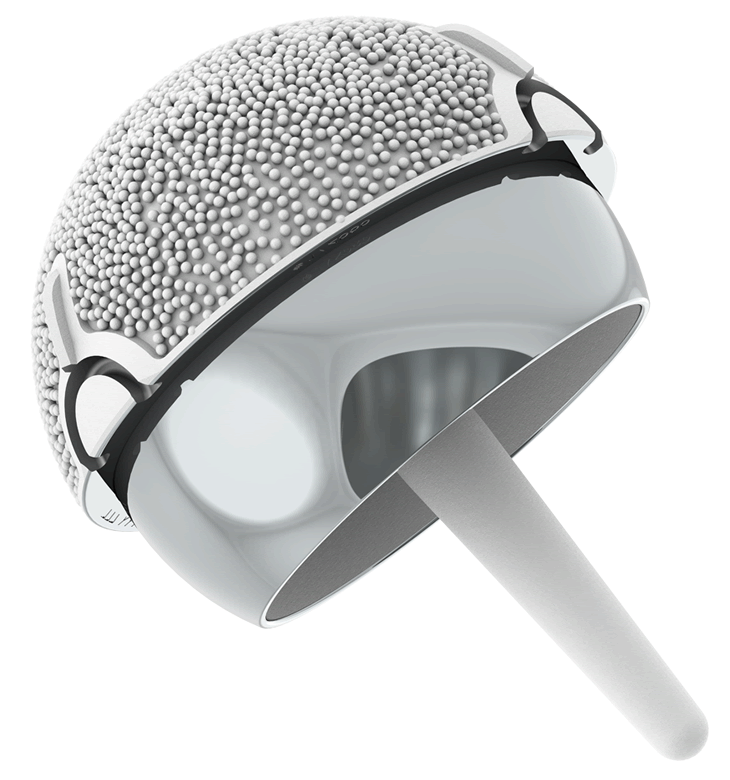ADEPT® Hip Resurfacing
A Patient Guide to Hip Replacement
Hip Replacement Vs Hip Resurfacing
Total hip replacement (THR) surgery is one of the most successful interventions in the world. However, many younger patients (usually under 65 years old) with osteoarthritis must face a choice between delayed surgery or a limited return to activity with a high risk of reoperation in their lifetime.
Hip resurfacing is a more conservative treatment option intended for younger patients, which prolongs the time before a THR is required. The clinical success of currently available metal-on-metal (MoM) hip resurfacing devices has exceeded early expectations and, particularly for younger males, can offer many more years of active life before a traditional total hip replacement is required.
Benefits of Choosing Hip Resurfacing
In a conventional THR the ball of the thigh bone is completely removed and replaced with a new ball on a stem which is inserted into your thigh bone. A hip resurfacing, however, only removes your worn cartilage, preserving the neck and most of the head of your thigh bone. A thin-shelled ball is placed on the top of your thigh bone and a thin shell is placed into the socket (your pelvis).
Unlike THR, which uses a smaller size ball-in socket (usually up to 32mm diameter), hip resurfacing restores the natural size of your own hip (commonly over 50mm diameter). This offers an immediate advantage for joint stability, and postoperative dislocation is extremely rare: 3-5 times less likely than for a THR1.
Resurfacing of the femoral head allows for better restoration of the anatomy2 and a more natural gait3,4 when compared to a traditional THR. Expert surgeons agree that they allow their hip resurfacing patients to return to wider variety of sport and leisure activities without restriction as compared to THR, and return to activity is commonly much earlier in the postoperative recovery phase5,6.

Patients report a high level of activity including running3,5,6,7,8 and high levels of activity are maintained for more than 10 years after their operation8. If a hip resurfacing needs redoing in the future, the operation is technically easier than if a THR needs to be redone. For the thigh bone the procedure is essentially the same as a first-time THR.
The ADEPT® Hip Resurfacing
The ADEPT® Hip Resurfacing is intended to replace the worn or damaged cartilage within your hip joint. It is designed to work with the natural structures (ligaments and muscles) of your hip to provide you with a stable joint and a range of movement that allows you to perform normal everyday tasks with reduced or no pain.
The ADEPT® Hip Resurfacing has been in clinical use since 2004 and is demonstrated to be a very successful procedure. Best results are associated with males and larger sizes. The ADEPT® is independently awarded an ODEP 15A rating based on the quality and duration of its available clinical data9.

Who is Suitable for a Hip Resurfacing?
As with any joint replacement device, individual and surgical factors can determine the suitability of the procedure or impact the lifetime of the device. Talk to your doctor about whether it is appropriate for you, and to understand the risks, precautions and other measures that may be relevant to you.
References
1. National Joint Registry 19th Annual Report, 2022 www.njrreports.org.uk.
2. Lombardi AV et al. Clin Orthop Relat Res. 2011; 469(6): 1547-53.
3. Barrack RL et al. Clin Orthop Relat Res. 2013; 471: 3803–3813.
4. Aqil A et al. Int Orthop. 2013; 37 (5): 795-801.
5 Van Der Straeten C and De Smet KA. Hip Int. 2016; 26 (1):1-7.
6. Girard J. Orthop Traumatol Surg Res. 2015; 101(1 Suppl): S25-9
7. Plate JF et al. J Long Term Eff Med Implants. 2013; 23(4):315-21.
8. Haddad FS et al. Bone Joint J. 2015; 97-B:617–22.
9. ODEP rating for bearing sizes 48-58mm. Latest
